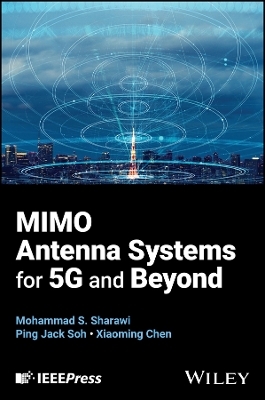
MIMO Antenna Systems for 5G and Beyond
Wiley-IEEE Press (Verlag)
978-1-119-93251-2 (ISBN)
Multiple-input multiple-output (MIMO) antenna systems use multiple sets of antennas to increase the capacity of a radio link, or to send and receive multiple simultaneous data signals over the same radio channel. It’s become an increasingly integral part of wireless and mobile data networks, from the earliest generations of wireless internet to cutting-edge 5G systems. The coming 6G networks will also rely on 6G antenna systems, making it all the more critical for the next generation of engineers and antenna designers to have a firm grasp of this foundational technology.
MIMO Antenna Systems for 5G and Beyond offers a timely introduction to these systems and their design principles. Incorporating the latest designs and a comprehensive overview of current system configurations, it provides complete design procedures and performance metrics for MIMO systems. The result is a one-stop shop for all MIMO applications and wireless standards.
MIMO Antenna Systems for 5G and Beyond readers will also find:
The first book ever to cover MIMO design practices specific to 5G wireless communications—and beyond
Detailed discussion of MIMO configurations including passive, reconfigurable, beamforming, and more
Detailed illustrations and design files
MIMO Antenna Systems for 5G and Beyond is ideal for practicing engineers, as well as researchers in wireless and radio engineering sectors.
Xiaoming Chen, PhD, MSc, is a Professor at Xi’an Jiaotong University, Xi’an, China. He received his MSc and PhD in electrical engineering from Chalmers University of Technology, Gothenburg, Sweden. He received the IEEE outstanding AE awards six times from 2018 to 2023. He was also a recipient of the URSI (International Union of Radio Science) Young Scientist Award in 2017 and 2018. Ping Jack Soh, PhD, MEng, is an Associate Professor at the University of Oulu, Finland. He received his master’s degree from Universiti Teknologi Malaysia and his PhD from KU Leuven, Belgium. Dr. Soh was the recipient of the URSI Young Scientist Award in 2015, the IEEE MTT-S Graduate Fellowship in 2013 and the IEEE AP-S Doctoral Research Award in 2012. He is also a Chartered Engineer registered with the UK Engineering Council. Mohammad S. Sharawi, PhD, is a Principle Engineer at Blue Origin LLC, and an Affiliate Professor of Electrical and Computer Engineering at the University of Washington, USA. He was with Polytechnique Montreal, Canada between 2019-2023, and KFUPM Saudi Arabia between 2009-2018. He holds 28 patents with the US patent office and more than 400 publications. Dr. Sharawi is a distnguished lecturer of the IEEE Antennas and Propagation Society, and a Fellow of the IEEE.
About the Authors xv
Preface xvii
Acknowledgments xix
1 Introduction 1
1.1 Wireless Technology Evolution 3
1.2 Benefits of MIMO Technology 6
1.3 Future Technology Trends 7
1.4 Book Organization 9
2 MIMO Antenna Fundamentals and Characterization Methods 13
2.1 Performance Metrics for Conventional Antennas 13
2.2 Performance Metrics of MIMO Antenna Systems 15
2.3 MIMO Antenna Characterization Methods 28
2.4 Summary 36
3 Feed Network Design and Analysis for MIMO Antenna Systems 41
3.1 Impedance-Matching Networks 41
3.2 Passive Feeding Networks 50
3.3 Active Feed Networks 56
3.4 Beamforming Networks 65
3.5 Summary 79
4 Passive MIMO Antenna Systems 85
4.1 Single-Band Implementations 87
4.2 Multi-Band MIMO Antennas 102
4.3 Wideband and Ultra-Wide Band (UWB) MIMO Antennas 113
4.4 Practical Implementations 136
4.5 Design Examples 140
4.6 Summary 142
5 Active Reconfigurable MIMO Antenna Systems 147
5.1 Frequency-Reconfigurable MIMO Antennas 147
5.2 Pattern Reconfigurable MIMO Antennas 155
5.3 Polarization Reconfigurable MIMO Antennas 161
5.4 Challenges and Practical Considerations 165
5.5 CAD Modeling Example 166
5.6 Summary/Conclusion 168
6 Massive-MIMO (m-MIMO) Antenna Systems 173
6.1 Advantages of m-MIMO 173
6.2 m-MIMO Antenna Implementations 176
6.3 5G Massive-MIMO Array Example (Practical/Industry Related) 185
6.4 Challenges in m-MIMO Antenna Designs 187
6.5 Conclusion 188
7 Recent Topics in MIMO Antenna Systems 191
7.1 On-Chip and On-Package MIMO Antenna Systems 192
7.2 Millimeter-Wave MIMO Antenna Systems 199
7.3 Sub-THz Antennas 204
7.4 MTS 217
7.5 Reflective Intelligent Surfaces 239
7.6 MIMO OAM 258
7.7 MIMO Antennas for Space Applications 263
8 Decoupling Techniques for MIMO Antenna Systems 285
8.1 Mutual Coupling and Its Impact on MIMO 285
8.2 Decoupling Techniques 298
8.3 Challenges and Practical Considerations 315
8.4 Conclusions 316
References 316
9 Measurement Methods for MIMO Antenna Systems 323
9.1 Over-the-Air Tests in Reverberation Chamber 323
9.2 Multi-Probe Anechoic Chamber 332
9.3 Radiated Two-Stage Method 348
9.4 Other Testing Methods 356
References 365
Index 371
| Erscheinungsdatum | 05.09.2024 |
|---|---|
| Sprache | englisch |
| Themenwelt | Technik ► Elektrotechnik / Energietechnik |
| Technik ► Nachrichtentechnik | |
| ISBN-10 | 1-119-93251-3 / 1119932513 |
| ISBN-13 | 978-1-119-93251-2 / 9781119932512 |
| Zustand | Neuware |
| Haben Sie eine Frage zum Produkt? |
aus dem Bereich


